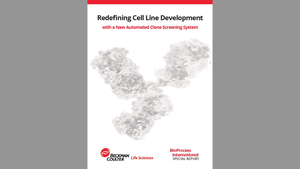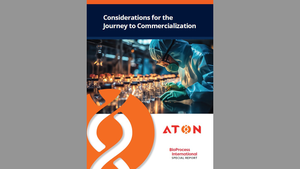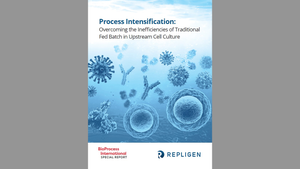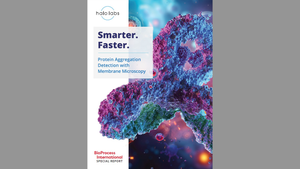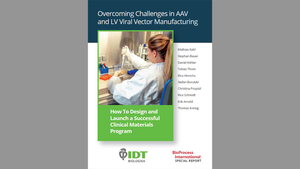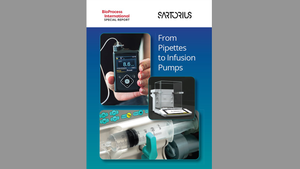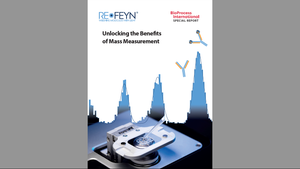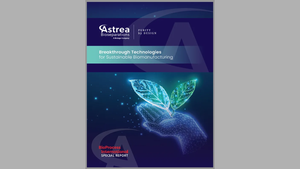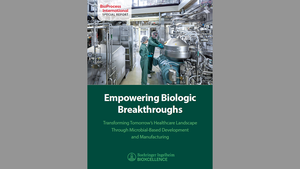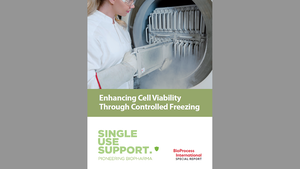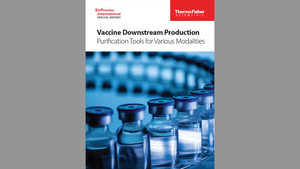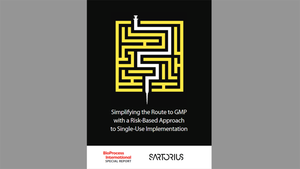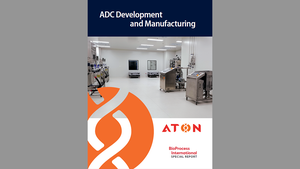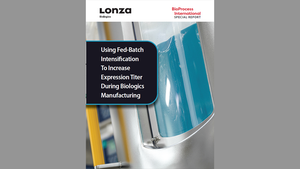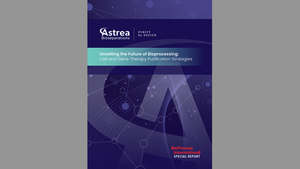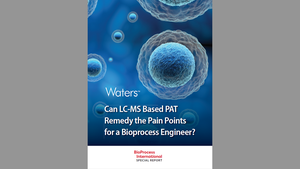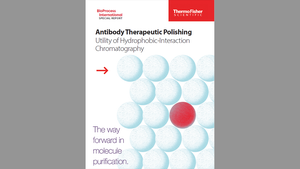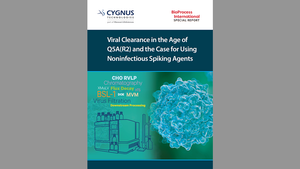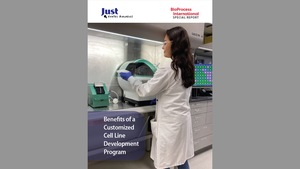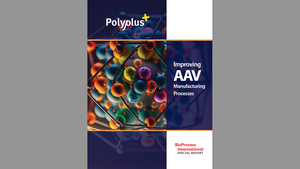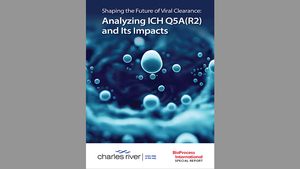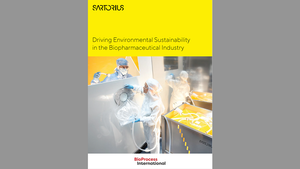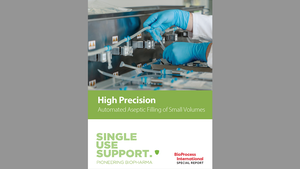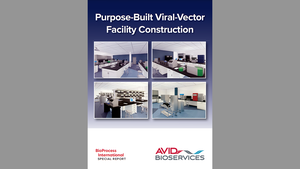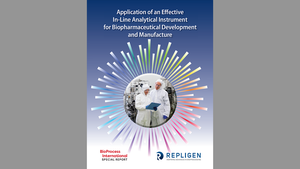Special Reports
The Cydem VT system combines multiple trusted Beckman Coulter Life Sciences technologies into one advanced platform that empowers lab managers with a far more effective, higher-throughput method for top clone screening in Cell Line Development—offering increased confidence that promising clones don’t get overlooked in the process of consistently selecting the best.
Key features:
Register or Login and hit Download Now to get the full Special Report.
The journey from preclinical development to commercialization of a new biopharmaceutical is long and challenging. The entire process requires persistence, adaptability, and strategic foresight. Only with a well-coordinated effort across disciplines and business functions can a new biologic drug successfully advance from laboratory to market. Partnering with a CDMO can be invaluable in navigating such challenges to provide flexibility, enabling drug sponsors to focus on their core competencies while relying on their partners to handle the intricacies of manufacturing and regulatory compliance. Such partnerships can reduce risks significantly and help ensure that a new biologic reaches the market as efficiently as possible. Learn key considerations for the journey to commercialization.
Register or Login and hit Download Now to get the full Special Report.
byMin Park
Explore how process intensification can transform your biomanufacturing processes. The special report highlights the inefficiencies of traditional batch and fed-batch methods and demonstrates how process intensification technologies, such as the XCell ATF System and the KrosFlo TFDF System, can improve the economics, productivity, and sustainability of your biologics and cell and gene therapy manufacturing.
You’ll learn how Repligen's intensification systems overcome challenges of filter fouling, scalability, and automated control, and you can see real-world case studies showcasing significant improvements in product yields and cost-efficiency.
Download the report to explore how PI can boost productivity, streamline your processes, and position your operations for long-term success. Fill out the form to access actionable insights that will drive your biomanufacturing strategies forward.
Register or Login and hit Download Now to get the full Special Report.
Sponsored Content
Smarter, Faster Protein Aggregation Detection with Membrane Microscopy: Rapid, Accurate Identification and Characterization of Subvisible Particles with Next-Generation MicroscopySmarter, Faster Protein Aggregation Detection with Membrane Microscopy: Rapid, Accurate Identification and Characterization of Subvisible Particles with Next-Generation Microscopy
Unlock the potential of your biopharmaceutical research with our latest report on advanced particle detection. "Smarter, Faster Protein Aggregation Detection with Membrane Microscopy" explores how cutting-edge technologies like fluorescence membrane microscopy (FMM) and backgrounded membrane imaging (BMI) are revolutionizing the identification and characterization of subvisible particles. Discover how these innovations offer rapid, accurate insights into particle origins, enabling you to enhance drug stability and safety with unprecedented precision. Download the report now to stay ahead in the ever-evolving field of biologics.
Register or Login and hit Download Now to get the full Special Report.
Gene & immune therapies have become increasingly important as they have the potential to treat and cure challenging diseases, such as cancer.
At IDT Biologika, we specialize in the contract development and manufacturing of virus-based vaccines and gene & immune therapies. Our team has extensive experience in the development and production of viral vectors, particularly in the use of Adeno-Associated Virus (AAV) platforms and also provide own cell lines for manufacturing. We are prepared to help you to overcome challenges in the process development and manufacturing of your AAV and LVV products.
Did you also know that IDT Biologika has already manufactured one of the first FDA and EMA approved commercial oncolytic products?
Read more about how IDT Biologika's expertise and experience can best serve your projects.
Register or Login and hit Download Now to get the full Special Report.
Precision in volume delivery is critically important for both the biopharmaceutical and medical device industries. This special report discusses how accurate volume measurement affects patient safety, product quality, and regulatory compliance. Sartorius emphasizes the roles that infusion pumps, laboratory pipettes, and quality control (QC) measures play in ensuring reliable and reproducible results.
Register or Login and hit Download Now to get the full Special Report.
As the monoclonal-antibody (mAb) market continues to grow, it is becoming increasingly important for pharmaceutical and biotech companies to accelerate process development and establish a scalable manufacturing process capable of achieving high titers and consistent product quality. Central to this is a cell culture media and feed system that can provide the required nutrients for optimal cell growth, viability, and function, as well as facilitate a seamless transition from development to clinical and commercial manufacturing.
However, choosing an appropriate system can be a complex and time-consuming process, often requiring the evaluation of multiple medium and feed options. Platform systems, consisting of a medium and complementary feed developed for a specific cell line and application, have emerged as a valuable option for developers to help simplify selection and increase scale-up efficiency.
To meet the need for high-performance platform mAb manufacturing solutions, Thermo Fisher Scientific has dev...
Antibody aggregation, protein binding, sample purity, oligomerization, protein-DNA interactions… All this and more is easily accessible with mass photometry — a rapid, label-free technique that measures the mass of single particles directly in solution. Requiring no more than 20 μL of sample with no sample preparation steps, mass photometry generates intuitive data in minutes. It is transforming analytical workflows in structural biology, CGT and biopharma R&D. Read this special report to learn how and why hundreds of laboratories now use mass photometry.
Register or Login and hit Download Now to get the full Special Report.
Astrea Bioseparations leads in sustainable biopharma manufacturing with its innovative PuraBead
®
agarose beads, derived from sustainably harvested red seaweed. The eco-friendly manufacturing process eliminates oil-derived solvents and minimizes waste, offering a superior biodegradable alternative to synthetic products. AstreAdept
®
nanofiber technology boosts productivity with high binding capacities and reduced processing times, while also lowering energy and water consumption. Additionally, Astrea Bioseparations' ready-to-use disposable systems, including Evolve
®
Process columns and Refresh Kits, streamline production, reduce cross-contamination, and enhance efficiency.
Explore these breakthrough innovations in detail by reading the full report.
Register or Login and hit Download Now to get the full Special Report.
Downstream processing comprises critical unit operations for harvesting, purifying, and recovering target biomolecules for use as biopharmaceuticals. Tangential-flow filtration (TFF) has been a cornerstone technology in biomanufacturing, enabling precise, efficient separation and concentration of protein products. Capture and polishing chromatography steps ensure the safety of such products by separating target molecules from impurities and contaminants. Though important, such operations are known to be time and resource-intensive. To minimize production costs and enhance process economics, biopharmaceutical manufacturers must investigate novel solutions. In this special report, Mark Perreault and Adam Nelson of Repligen explore two solutions designed to simplify downstream processes: TangenX SC TFF devices and OPUS prepacked chromatography columns.
First, Perreault highlights how TangenX SC technology minimizes setup and decommission times, improving the productivity of ultrafiltration and diafiltration...
UFDF is a critical step in the downstream process that commonly uses tangential flow filtration (TFF) techniques. Traditional UFDF relies on mass-balance monitoring, which presents challenges such as variability across runs and the need for frequent sampling. As the demand for high-concentration monoclonal antibody (mAb) drugs rises, there's a growing pressure to optimize processes while maintaining critical quality attributes. Process Analytical Technology (PAT) offers a solution by enabling real-time protein concentration monitoring using ultraviolet-visible (UV-vis) spectroscopy through Variable Pathlength Technology (VPT). The KrosFlo FS-15 TFF system, incorporating VPT technology, allows for proactive control based on immediate concentration feedback, enhancing process efficiency and product quality. Through experimental validation across a range of high-concentration products, this approach demonstrated significant improvements in process control, reducing errors, and ensuring consistent quality thr...
Microbial expression systems are crucial in developing innovative medicines and expanding development pipelines due to the broad range of molecule formats that can be obtained using this technology. However, this approach can be challenging as it requires a variety of manufacturing processes to handle these diverse molecule formats. This is where collaboration with an experienced organization comes into play. Boehringer Ingelheim, known for its proficiency in this technical domain, has a proven track record with 19 commercial microbial products and successful audits and regulatory compliance. The company's commitment to quality and flexibility in implementing production processes make it a reliable partner. Its technology-platform neutrality also simplifies technology and process transfers.
Fill out the form below to read the full report.
Cell viability is the cornerstone of successful outcomes in biotechnology research and therapeutic applications. However, freezing cells, particularly in advanced therapy or vaccine manufacturing, poses significant challenges in maintaining viability after thawing. Freezing rates and specific additives must be understood and controlled so that sensitive cells are not damaged. To identify the optimal freezing rate for maximum cell viability, Single Use Support conducted a comprehensive study using its controlled rate cryogenic freezer to freeze Chinese hamster ovary (CHO-K1) cells.
Fill out the form below to read the full report.
As vaccine modalities abound, this special report provides a consolidated overview of a variety of chromatographic purification tools for various vaccine modalities, such as virus-like particles (VLPs), viral vectors, recombinant protein subunits, and mRNA-based vaccines. This includes a successful protein-based malaria vaccine production process highlighting the use of the C-tag affinity tag system as a versatile tool for the detection and purification of therapeutic recombinant proteins. Next, it explores the scalable purification of mRNA-based vaccines, such as those deployed against COVID-19, with the application of POROS(TM) Oligo(dT)25 affinity resin. Further, cation exchange chromatography tools are highlighted by the purification of VLPs against human papillomavirus (HPV) using POROS(TM) HS50 resin. Additionally, the baculovirus expression vector system (BEVS) for insect-cell expression of recombinant proteins is presented, with a focus on VLP manufacturing and purification tools, showcasing the c...
In order to enhance access to life-saving medicines, the biopharmaceutical industry must prioritize more efficient therapeutic production. However, the environmental impact of manufacturing choices is facing increasing scrutiny. Sustainability opportunities within the biopharmaceutical sector encompass reducing the environmental footprint, addressing resource depletion, and effectively managing waste through repurposing and recycling. During a recent panel discussion, sustainability experts from Sartorius and their collaborators shared valuable insights on enhancing the sustainability of manufacturing processes. These insights encompass adopting single-use technologies, improving process efficiency, and fostering productive collaborations. This Special Report offers extracts from those enlightening discussions, along with relevant excerpts from Sartorius' white paper on sustainability in the biopharmaceutical industry.
Over the past few years, there has been rapid progression and commercialization of mRNA vaccines and therapeutics, in large part due to the emergence of COVID-19. The lipid nanoparticle (LNP) technology underpinning this new drug modality enabled biopharmaceutical companies to adapt existing knowledge and processes developed for other applications to create vaccines within an accelerated timeline. However, navigating the regulatory and manufacturing landscape surrounding these developments has not been without its challenges.
In this new Special Report, gain insights into opportunities, challenges, and strategies for success, including:
Antibody–drug conjugates (ADCs) are complex therapeutics that offer a unique combination of selectivity and potency. Commercial demand for ADC therapeutics is projected to continue to increase while facing a very complex development, manufacturing, and supply chains challenges. Given the complexities of ADC development and manufacturing, there are clear advantages to partnering with a single contract development and manufacturing organization (CDMO) that offers a complete set of services. As ADCs continue to grab a larger share of clinical pipelines, it becomes increasingly essential to select a CDMO partner with the experience and expertise to accelerate timelines while minimizing risk.
Fill out the form below to read this special report and learn more about ADC market, growth, challenges, and solutions to accelerate ADC pipelines to market.
byMin Park
Improving manufacturing productivity is a major goal in today’s biopharmaceutical industry, especially as new and increasingly complex molecules are fundamentally changing technological and operational approaches to drug development. Process intensification can accelerate the pace of innovation by introducing advanced process-development techniques and high-productivity manufacturing platforms.
N
– 1 perfusion represents a promising strategy for increasing the density of cells that are used to inoculate fed-batch cultures in production-scale (
N
-stage) bioreactors ultimately increasing product accumulation within a production bioreactor.
In this special report, Ruth Rowland-Jones describes Lonza’s achievement to establish a platform process for high inoculum density (HID) fed-batch culture of Chinese hamster ovary (CHO) cells. Such efforts included implementation of advanced process analytical technologies (PATs) including capacitance probes and Raman spectroscopy for automated monitoring and adjustmen...
Discover the cutting-edge advancements in bioprocess intensification and cell & gene therapy purification with this comprehensive custom report from Astrea Bioseparations. Explore the latest innovations and breakthroughs that promise to revolutionize the field.
HCPure™ Host Cell Protein Clearance Resin: Bioprocess Intensification through Mixed-Mode Chromatography
Delve into the world of mixed-mode chromatography and how HCPure™ Host Cell Protein Clearance Resin is transforming bioprocess intensification. Learn how this technology is enhancing purification efficiency and streamlining biomanufacturing.
Enhanced Efficiency in Cell & Gene Therapy: The Role of Plasmid DNA Purification
Uncover the critical role of plasmid DNA purification in improving the efficiency of cell and gene therapy production. Explore the latest techniques and strategies that enable more efficient and reliable purification processes.
Scalable Downstream Purification with
Lenti
HERO®: Safeguarding Lentiviral Vector Yield Expressed by A...
The past decades have brought a tremendous increase in new biologics and biotherapeutics that offer patients more efficient and safer treatment options than they had before. Such revolutionary innovations in biopharmaceuticals are
to a large extent thanks to advancements in upstream research and development, which are important drivers of bioprocesses. But despite this unceasing progress, upstream bioprocess engineers continue to face challenges and pain points in their work. In this article, Magnus Wetterhall, Global Marketing Manager — Bioprocess at Waters Corporation, highlights some of those pain points with a view to how comprehensive process analytical technologies (PATs) based on liquid chromatography (LC) and mass spectrometry (MS) can help to address such issues in development and manufacturing of new biotherapeutics.
Fill out the form below to read the full report now.
The ultimate goal of downstream purification is to reliably and predictably produce a safe drug product suitable for therapeutic use in humans. To this end, biomanufacturing process- and product-related impurities such as host cell proteins (HCPs), residual DNA, leached protein A, process leachables and extractables, adventitious and endogenous viruses, endotoxins, antibody aggregates, and other antibody variants all must be removed to acceptable levels in conformance with regulatory guidelines.
Downstream processing of traditional therapeutic monoclonal antibodies (MAbs) has become relatively standardized with an affinity capture step followed by various polishing steps as needed. For novel engineered therapeutic antibody formats, the standardized platform may be suboptimal, and process development scientists can use various chromatographic tools to improve recovery and purity in both the affinity and polishing steps. Depending on a specific residual impurity profile and process challenges, an anion-exch...
As viruses can arise during the manufacture of biopharmaceuticals, regulatory agencies require “viral clearance” validation studies for each biopharmaceutical prior to approval. For example, Type C Retrovirus-Like Particles (RVLP) are endogenously produced during CHO cell expression. As such, regulatory agencies require proof that downstream process steps can effectively remove or inactivate retrovirus. A model mammalian virus, Xenotropic Murine Leukemia Virus (XMuLV) is typically used to demonstrate RVLP clearance. However, the establishment of RVLP quantification methods has made it possible to track the removal of actual endogenous RVLP throughout the downstream process. Additionally, the recent draft of ICH Q5A revision states that, “For CHO cell-derived products, CHO-derived endogenous virus particles (RVLP) can also be used for viral clearance experiments.”
In this Special Report, you will learn more about the use of a BSL-1 compatible, non-infectious RVLP and MVM particles to predict viral clearanc...
Cell line development at Just-Evotec Biologics is focused on lowering the cost of manufacturing and creating highly productive cell lines for our clients and partners. To achieve this, we leverage our own in-house GS knockout CHO host cell line, which has been shown to support cell densities up to 80 M cell/mL and productivities upwards of 5 g/L/day in our perfusion bioreactor platform. Additionally, we have implemented advanced instruments and liquid handling automation to increase the throughput of processes that are historically major bottlenecks. Examples of this include semi-automated, independent transfections of up to 32 different expression vectors or high throughput single-cell cloning/screening of up 1000 clones. Paired with our process development and manufacturing expertise, we continue to push the envelope on improving drug costs and have enabled many of our clients to file for BLAs.
Fill out the form below to read the full special report from Just-Evotec Biologics.
When evaluating a new process for viral vector manufacturing, you may be wondering what the best path forward is to save time and resources while ensuring to produce enough data to support the robustness of your future manufacturing and scale-up.
Polyplus
®
free of charge DoE service is the combination of our expertise in the field of nucleic acid delivery and in DoE methodology to support you through the evaluation of our transfection reagents. As each process is different, this service helps to choose optimal conditions for transfection experiments with Polyplus
®
FectoVIR
®
-LV, FectoVIR
®
-AAV and PEIpro
®
transfection reagents. We aim to help you cut down time and cost of process development to decrease cost per dose of treatment and improve patient access to ATMPs.
Fill out the form below to download the full report now.
In October 2022, a new draft of ICH Q5A (R2) was released, the first such update in more than 20 years. This draft revision was necessary to reflect current scientific knowledge and biotechnology advances such as new product types that are amenable to viral clearance and alternative virus clearance validation strategies.
In this report, we delve into the evolving landscape of viral clearance practices, focusing on the implementation of continuous manufacturing, advancements in study design, and the implications for cell and gene therapy products. Additional topics discussed include the vital role of detergent treatment, low pH treatment, and viral filtration in shaping the future of viral clearance.
Stay ahead of the curve. Sign up today and prepare yourself, and your team, for the next frontier in viral clearance.
Fill out the form below to read the special report from Charles River now.
In order to enhance access to life-saving medicines, the biopharmaceutical industry must prioritize more efficient therapeutic production. However, the environmental impact of manufacturing choices is facing increasing scrutiny. Sustainability opportunities within the biopharmaceutical sector encompass reducing the environmental footprint, addressing resource depletion, and effectively managing waste through repurposing and recycling.
During a recent panel discussion, sustainability experts from Sartorius and their collaborators shared valuable insights on enhancing the sustainability of manufacturing processes. These insights encompass adopting single-use technologies, improving process efficiency, and fostering productive collaborations. This Special Report offers extracts from those enlightening discussions, along with relevant excerpts from Sartorius’ white paper on sustainability in the biopharmaceutical industry.
Fill out the form below to read the full report from Sartorius now.
Market experts recommend automated filling systems for drug developers seeking to reach the next level in drug-substance management. Many companies are starting automation initiatives, which suggests an overall trend towards automated filling. The stakes are high. Increased process deviation in fluid management can lead to increased loss of valuable biopharmaceutical products. Automated and standardized aliquoting of biopharmaceutical drug substances into single-use bioprocess containers simplifies the manufacturing process while improving throughput, speed, and filling accuracy.
Fill out the form below to read the full report now.
In this report, Avid shares its approach to producing high-quality, safe, and effective viral vectors for use in gene therapy and vaccine applications. The company is dedicated to minimizing the risks for, and associated high costs of cross-contamination and contamination during manufacture of viral-vector products. To this end, the contract development and manufacturing organization (CDMO) is establishing a rigorous quality control program as it completes its new facility. In 2021, Avid began building a 53,000-ft
2
site in Costa Mesa, CA, close to its main campus in Tustin, CA. The process development (PD) and analytical development laboratories were completed in 2022, and the good manufacturing practice (GMP) facility is expected to be ready in mid-2023.
The author summarizes how Avid designed engineering and quality controls to provide several layers of protection. He describes use of LoPA (layers of protection analysis) as a major tool in Avid’s risk-assessment toolbox. That enables the company to co...
There’s no doubt that CHO cell lines are being pushed to their limits:
While advancements are being made, little has been done to characterize the physical stability of secreted antibodies from their inception during CHO cell line development. Scientists have been forced to stabilize biologics that were not designed with aggregation in mind from the ground up, often with limited success.
But that’s about to change.
Aura™ immunoassays with particle characterization bridge the gap between cell line development and developability to enable, for the first time, pre-screening for antibody stability once MAbs are secreted from CHO cells. Aura systems enable quick characterization of unfiltered cell lines samples through low-volume, high-throughput imaging, counting, sizing, and identification. Analyzing biologically complex cellular and protein samples present in CLD to characterize secreted protein stability has never been faster or more accurate. Aura PTx can quickly and accurately characterize secreted antib...
The rapid advancement and competitive environment of the modern biopharmaceutical industry, accompanied by the need for continuous quality improvement, demand robust analytical instruments. Analytical technology is one key factor contributing to the quality and safety of finished products. Ongoing improvements in analytical instruments are needed to address new challenges, including specificity of target substances, high complexity of matrices, and multiple production stages with a number of input and output parameters and peculiarities. Those factors point to the demand for a versatile solution, one that can be used accurately and reliably for analyses of intermediate
Ultraviolet-visible (UV-vis) instruments constitute a large portion of the analytical tool set currently used in the biopharmaceutical industry, although most traditional UV-vis technologies have a narrow detection range that can limit functionality in direct applications. Because the light absorbance value in UV-vis is directly proportiona...
Subscribe to receive our monthly print or digital publication
Join our 70,000+ readers. And yes, it's completely free.
